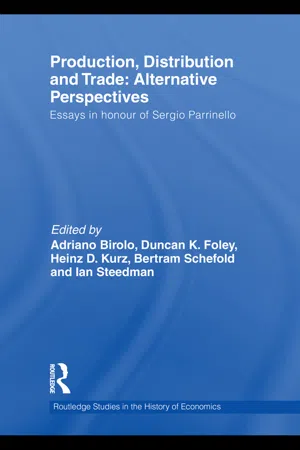1 Introduction
The classical economic theory rehabilitated by Sraffa (1960) has had a great impact on economists who work on the reproducibility of a capitalist economy and distribution of income. It is really amazing to see that not only nonmainstream economists but mainstream ones are deeply affected by the rehabilitation of classical economics. It is quite natural to develop further the idea of reproducibility of a pure capitalist economy in order to capture more complicated aspects of a modern capitalist economy where environmental issues among others are gaining more serious attention. Obviously, sustainable development has become an unavoidable concept for human beings, and sustainability is a natural extension of reproducibility of a capitalist economy.
To develop an economic theory in this direction, one important problem must be sorted out and answered; how one deals properly with residuals, which may be required neither for consumption nor for production, in an economic model. The purpose of this chapter is to consider this problem following the classical tradition, and demonstrate how a linear production model based upon the tradition can contribute to the understanding of sustainable development.
This problem has been ignored for such a long time, evidenced by the fact that the assumption of free disposal has been adopted. It is quite interesting to see that this assumption was adopted by both mainstream and non-mainstream economists. It was such a convenient assumption that it was hard for quite a few economists to dispense with it.
It must, however, be remembered that such a distinguished scholar as Debreu (1962) tackles the problem in a rather early stage of the history of the general equilibrium analysis. He proves the existence of an equilibrium solution without depending upon the free-disposal assumption in an abstract economic model. Quite a few researchers follow his research agenda, and develop an elegant model without the assumption (Hart and Kuhn 1975; Bergstrom 1976; and Gay 1979). One common feature of their highly sophisticated general equilibrium models is that prices of commodities which are disposed of must be negative.1 Consequently, they have shown that commodities in a broad sense consist of not only goods but also bads.
A further important contribution to the problem comes from a different school, namely, a modern classical economist. Franke (1986) analyzes a Sraffian type of general joint production model, using the concept of a cost-minimizing system. He tries to show that a classical notion of equilibrium holds valid in a more general setting which reflects realities, getting rid of the assumption of free disposal. As in the cases above, it is shown that prices of some commodities may be negative, when an equality system is adopted for description of a quantity aspect of an economy.
He notices the significance of negatively priced commodities (discommodities) more than the mainstream economists we have mentioned above, and explains the meaning of negative prices. Since negatively priced commodities, namely bads, are given more concrete meaning as waste than the previous studies, costly disposal processes and demand for bads are naturally introduced and well explained in his model.
To the best of the author’s knowledge, Lager (2001) is one of the most comprehensive studies on reproducibility of a capitalist economy in this line.2 Although he inherits the spirit of modern classical economists, he is more conscious of the problem of bads as an environmental issue, and deals with the longrun classical equilibrium with costly disposal processes more elegantly than previous researchers by means of a linear complementary theory.
One of the characteristics of his model is that restriction of free disposal is carefully introduced into his model, in the sense that a certain amount of disposal of residuals may be allowed instead of zero emission, although free disposal is restricted. Thus, whether some commodities may be goods or free goods is endogenously determined.
Yet, a more interesting feature of this chapter is that whether commodities in a broad sense may be goods or bads is shown to depend upon economic parameters as well as being endogenously determined. This means that residuals from production processes may possibly be resources which are positively priced, just like ordinary resources. Clearly, some residuals are bads or more simply waste which must be treated properly on a daily basis. In this way, the relativity of residuals’ nature is revealed in a very persuasive way.
Kurz (2006) surveys the goods/bads problem in the traditional theory of joint production, demonstrating that quite a few classical economists have noticed that some commodities may be negatively priced and they have tried to formulate the problem in one way or another. It is revealed that, although the existence of bads and activation of costly disposal processes have not been satisfactorily theorized, the problem itself has been debated among some classical economists.
By means of basic concepts and elementary diagrams, he also shows how one can deal with the costly disposal problem, following the classical tradition. From his argument, he concludes as follows:
